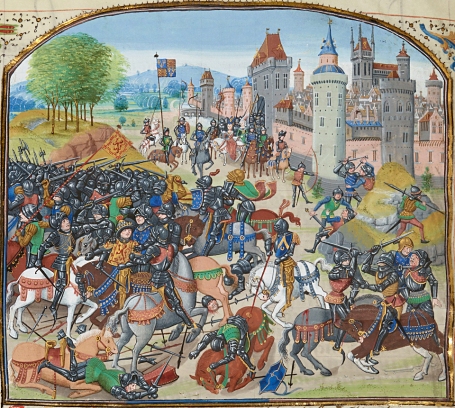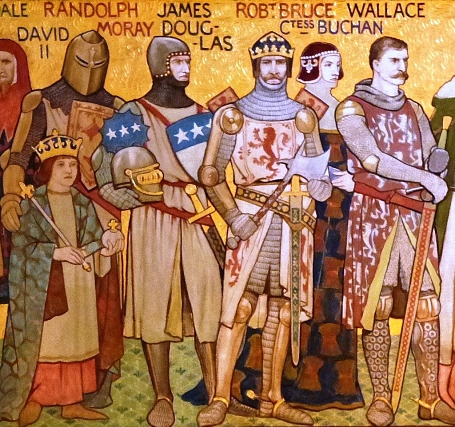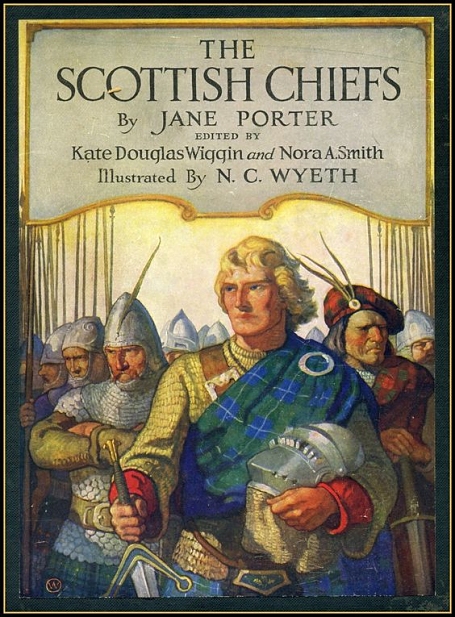The Life and Heroick Actions of the Renoun'd Sir William Wallace,
General and Governour of Scotland
by William Hamilton of Gilbertfield
Synopsis (Continued)
Wallace and his men head toward St. Johnstoun (Perth) which is again in English hands. Near Kinnoul he sees six English servants driving three empty carts. As the servants stop to load to carts with hay, Guthrie and his men kill the English; Wallace tells them quickly to dress in the servants' clothing. With Ruthven, Guthrie and Bisset, they cover five men with hay in each cart and head toward town. Ramsay and his men lie in ambush outside the town.
The carts being driven by Wallace and his men cross the bridge and arrive at the gate; Wallace quickly kills the porter and two others. Guthrie, Bisset and Ruthven join in, as do the men who have lain hidden in the carts. Ramsay's men break the ambush and enter the town to join in the fight. Sir John Psewart manages to escape through a different gate and makes haste to Methven Woods.
Wallace and his men find a hundred men hiding in a church, but spare none. Four hundred English are killed; seven score escape. Scots quickly fill the town.
Psewart, in the meantime, has moved on to Gask, then into Fife where Vallange is sheriff. They gather "men a num'rous company" and steathily moved to Auchterarder, where they wait to attack Perth again at first opportunity.
Wallace makes Ramsay his Captain in the town, and Ruthven sheriff, warning them to call on him without delay should they need him. He then leaves with a hundred men.
Wallace marches to Fife with his few trusted men. Sir John Psewart (Siward) gathers fifteen hundred men against him. Wallace is concerned; Bisset and Guthrie counsel him to flee by swimming the Tay to safety at Perth. Instead, he rallies his men reminding them how but forty had routed seven hundred at Elchock Park. They will stay and fight to the last man. Seeking cover in a wood, they make stout barricades from hewn oak trees and these rebuff Psewart's attacks. Wallace orders a gap opened in the barricade and prepares his archers and spearsmen to be strong against the attack of horse and men. They kill many who tried to enter. Crawford and Longueville command the barricade as Wallace goes with sixty to attack Psewart and his eight hundred men.
Vallange attacks the barrier, but it holds, with fifty English killed. Wallace's men fight hard against Psewart, killing eighty and causing them to retreat before regrouping at the forest barrier.
Sir John Psewart orders Vallange to contain the Scots within the forest while he goes for reinforcements, threatening his life as forfeit should Wallace escape.
Wallace calls to Vallange from the wood side to be a true Scot, change sides and join him in fighting the English. Vallange is persuaded and comes across with all his men. Ramsay and Ruthven arrive with three hundred men to join Wallace. Sir John Psewart returns with twelve hundred and chooses a plain on which to fight Wallace's army, which has grown to five hundred and sixty.
The English divide into two groups; the Scots charge from the woods into the fray. Fighting is fierce; Psewart strikes Bisset down but is himself killed at a stroke by Wallace. Many English die as the Scots win the day and move on to take Couper (Cupar) Castle, razing it to the ground.
Through all of Fife they defeat the English, save for Loch Leven, where a single company held the town. Wallace and eighteen chosen men foray there. He swims the loch and returns with the ferry boat to carry his men back out to the island where the castle stands. Thirty English found there are killed. There is celebrating before they set off back to Perth. Some of Wallace's men go north to seek supplies and some head west to rally support.
With fifty men Wallace ferries across Airth which is controlled by one hundred English under Thomlin Weir. A loyal fisherman leads them by secret ways to Airth Hill where they enter the stronghold and kill Weir and his hundred men. Wallace's uncle is freed from imprisonment and they take spoils from the town before heading back to Torwood.
After marching all night Wallace and his men arrive at Dumbarton, where a widow gives them food and one hundred pounds. Her nine sons swear an oath to Wallace and help by marking the dwellings where Englishmen are staying.
On entering the town they overhear ten English soldiers bragging. Wallace steps in, killing two and throwing another into the fire. The others are quickly killed by Keirley and Steven. The hostler identifies the English lodgings and they are burned to the ground.
They progress via Dumbarton Cave to Roseneath where eighty English returning from a wedding are set upon and forty killed. Others flee to the castle, but is soon taken and all within killed.
After seven days' rest Wallace and his men march to Faukland where they meet up with the Earl Malcolm, Richard of Lundie, Sir John of Graham, Adam Wallace, Barclay and Boyd. There, Wallace and his men spend the Christmas holiday season, celebrating and spending their time "in feasting sport and plays" until news arrives that Wallace's mother has died. He sends Jop and John Blair to see her buried, then throws off his grief and turns his attention back to freeing Scotland.
Sir William Douglas, Lord of Douglas-dale has two fine sons by his first wife, now dead. They were educated at the best schools in France. King Edward has imprisoned Sir William and forced upon him a marriage with Lady Frerres. That marriage produced two sons and the family - Sir William, the lady, and their two sons - lives pleasantly at Douglas-dale. Sanquhair is, during this time, a strong castle under command of a hard Englishman, Bewford, who is kinsman to Lady Frerres.
Douglas wants to assist Wallace in the uprising and feels no loyalty to King Edward. With Thomas Dickson and John Anderson he arranges to go with thirty stout Scotsmen and by devious plan gains entry to the castle. Douglas kills Bewford and all the English, save one, are killed. The escapee raises warning throughout English strongholds at Durisdear, Enoch, Lochmaben and Tibbesmoor. Douglas sends news to Wallace who, with four hundred men, marches on the castle of Kilsyth.
Meanwhile, Earl Malcolm, with two hundred men, ambushes Ravindale then marches on and burns in turn Linlithgow, Dalkeith and Newbottle.
Lauder and Seaton, attack and burn down North Berwick town, meeting with Wallace and Dickson. Scotsmen gather from around the borders, fifty with Hay from Peebles, sixty with Rutherford, and more until the army grew to six hundred.
At Sanquhair Castle Douglas is besieged, but the English quickly flee on news of Wallace's approaching force. Wallace and Earl Malcolm lead the chase and many Englishmen die.
All the while more support comes to the Scots: Currie and the Johnstoun, Kirkpatrick and Halliday rally their men and drive out the English.
Wallace heads to Carlavrock and then to Dumfries proclaiming peace and victory. Douglas survives and is made Keeper of lands from Drumlanrig to Ayr.
All the English flee the country, except Morton at Dundee where he is besieged. Wallace tells him his pleas for mercy are useless; when caught he will be hanged as an example to the English and for Edward's sake. News of this is quickly sent to Edward, who returned from fighting in France. He summons Bruce and all the bishops and barons, blaming them for this Scottish uprising.
At this time the English and French have been fighting over lands in France. King of France sends word to Wallace, asking that he come and help against the English. Wallace replies that he must wait and see what Edward is plotting before he can leave Scotland.
At the siege of Dundee word comes of a huge English force under Edward, one hundred thousand strong. Wallace leaves Scrimgeor and eight thousand men to maintain the siege, and sets off to Perth with two thousand men, planning to march south and meet the English.
King Edward sends a force of ten thousand under Woodstock, to march on Stirling Bridge and secure the crossing. Woodstock, however, passes by Stirling and marches into the north.
The ballad, The Life and Heroick Actions of the Renoun'd Sir William Wallace, General and Governour of Scotland, by William Hamilton of Gilbertfield, 1722, is in the public domain.

The Kingdom of England and the Kingdom of Scotland fought dozens of battles with each other. They fought typically over land, particularly Berwick-Upon-Tweed, and the Anglo-Scottish border frequently changed as a result. Read more at Wikipedia.

The First War of Scottish Independence was the initial chapter of engagements in a series of warring periods between English and Scottish forces lasting from the invasion by England in 1296 ... Read more at Wikipedia.

Digitized version of The Scottish Chiefs, by Jane Porter, a novelization published in 1921 by Charles Scribner's Sons, about William Wallace and the First Scottish War of Independence. Read online at archive.org.